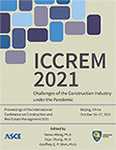Problems Encountered in Implementing Lean Construction and Solutions
Publication: ICCREM 2021
ABSTRACT
With the continuous acceleration of world economic development and globalization, China, as the world’s largest developing country, has also affected the construction industry’s growth accordingly. The construction industry consumes huge resources, so how to improve the level of project management and better meet the needs of the market and customers is necessary. Lean construction is a new type of project management model that can well meet the project’s goals. Although lean construction has many advantages, the full implementation of lean construction has certain problems due to various factors. This article mainly reviews the past research results, analyzes some obstacles encountered in lean construction’s overall performance, and gives some reasonable suggestions. The aim is to enable lean construction to achieve better development in the industry.
Get full access to this article
View all available purchase options and get full access to this chapter.
REFERENCES
Alves, T., Milberg, C., and Walsh, K. (2010). “Exploring lean construction practice, research, and education.” Proceedings of 18th Annual Conference International Group for Lean Construction, Haifa, Israel, 512–525.
Chen, Y. Q., and Zhang, H. R. (2007). “Application of precision construction theory in management of engineering projects.” China Harbour Engineering, (4), 74–76. (in Chinese).
Chiarini, A. (2011). “Integrating lean thinking into ISO 9001: a first guideline.” International Journal of Lean Six Sigma, 2(2), 96–117.
Cobra, R. L. R. B., Guardia, M., Queiroz, G. A., Oliveira, J. A., Ometto, A. R., and Esposto, K. F. (2015).“ ‘Waste’ as the common ‘Gene’ connecting cleaner production and lean manufacturing: a proposition of a hybrid definition.” Environmental Quality Management, 25(1), 25–40.
Cui, L. W. (2016). Application Research of Lean Construction Theory in Construction Site Management. Xi’an University of Architecture and Technology, Shanxi, China, 1–85. (in Chinese).
Ding, C. Q. (2020). “Research on the collaborative application of lean construction and BIM technology in construction phase.” Engineering Economy, 30(11), 55–60. (in Chinese).
Dües, C. M., Tan, K. H., and Lim, M. (2013). “Green as the new lean: how to use lean practices as a catalyst to greening your supply chain.” Journal of Cleaner Production, 40, 93–100.
Feng, S. Z., and Liu, Y. S. (2008). “Study on the theoretical system of lean construction.” Project Management Technology, (03), 18–23. (in Chinese).
Gu, N. N. (2013). Research on Green Construction Management Mode Based on Lean Construction. Nanjing Tech University, Nanjing, China, 1–55. (in Chinese).
Hosseini, S. A., Nikakhtar, A., Wong, K. Y., and Zavichi, A. (2012). “Implementing lean construction theory into construction processes’ waste management.” International Conference on Sustainable Design, 414–420.
Howell, G. A. (1999). “What is lean construction-1999.” Proceedings IGLC-7, Berkeley, U.S, 1–10.
Khodeir, L. M., and Othman, R. (2018). “Examining the interaction between lean and sustainability principles in the management process of AEC industry.” Ain Shams Engineering Journal, 9(4), 1627–1634.
Kibert, C. J. (1994). “Establishing principles and a model for sustainable construction.” Proceedings of First International Conference of CIB TG 16 on Sustainable Construction, Tampa, U.S., 3–12.
Kim, D., and Park, H. S. (2006). “Innovative construction management method: assessment of lean construction implementation.” KSCE Journal of Civil Engineering, 10(6), 381–388.
Koskela, L. (1992). Application of the new production philosophy to construction, Stanford university, Stanford.
Lukowski, J. (2010). “Lean construction principles eliminate waste.” Power, 154(8), 65–67.
Mollenkopf, D., Stolze, H., Tate, W. L., and Ueltschy, M. (2010). “Green, lean, and global supply chains.” International Journal of Physical Distribution & Logistics Management, 40(1-2), 14–41.
Nahmens, I. (2009). “From lean to green construction: a natural extension.” Construction Research Congress 2009, Washington, U.S., 1058–1067.
Ohno, T. (1988). Toyota production system: beyond large-scale production, CRC Press, Boca Raton.
Valente, C. P., Mourão, C. A. M. A., and Neto, J. D. P. B. (2013). “Lean and green: how both philosophies can interact on strategic, tactical and operational levels of a company.” Proceedings IGLC-21, Fortaleza, Brazil, 925–934.
Womack, J. P., and Jones, D. T. (1997). “Lean thinking-banish waste and create wealth in your corporation.” Journal of the Operational Research Society, 48(11), 1148–1148.
Yin, B. (2009). Lean Construction-Development Research in Construction Enterprise. Chongqing University, Chongqing, China, 1–47. (in Chinese).
Information & Authors
Information
Published In
Copyright
© 2021 American Society of Civil Engineers.
History
Published online: Dec 9, 2021
Authors
Metrics & Citations
Metrics
Citations
Download citation
If you have the appropriate software installed, you can download article citation data to the citation manager of your choice. Simply select your manager software from the list below and click Download.
